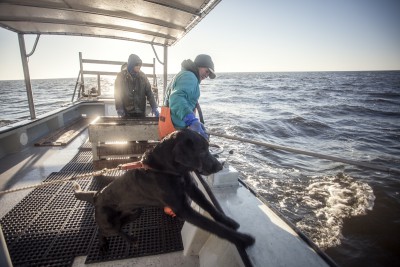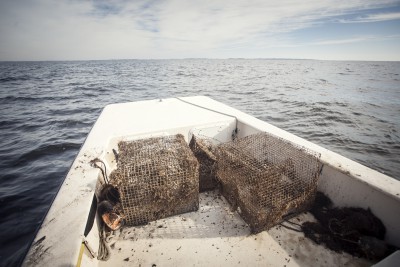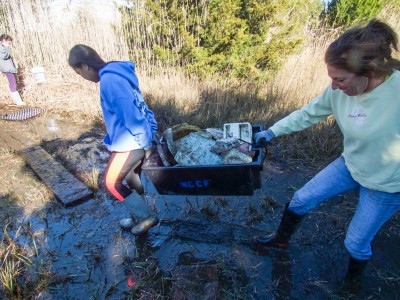MANTEO — Winter has come to the sounds and estuaries of the Outer Banks. The wind has been blowing from the north for more than a week and water temperatures have been steadily cooling. Trout and rockfish are heading out to sea or are living in holes in the warmer, deeper waters flowing from mainland rivers.

Blue crabs have burrowed into the mud of the sounds and crab fishermen, after one of the best years they’ve had recently, don’t have much to do this time of the year. It’s the ideal time to clean up the sound, to pick up the crab pots that have drifted away from their buoys – one of the most common types of marine debris seen at the end of the season.
Supporter Spotlight
Every year, the N.C. Division of Marine Fisheries closes the waters to commercial crabbing from mid-January to early February.
“They call it the no-potting period,” said Ladd Bayliss, coastal advocate at the N.C. Coastal Federation’s Manteo office. “During that time everyone is supposed to have their pots out of the water. Therefore, anything left in the water, except for those things that are legal, are considered abandoned and they will be removed.”
For a number of years, the division’s N.C. Marine Patrol had removed derelict pots during the no-potting period. “Crab-pot cleanup, we’ve been doing that since the early ’90s, maybe even earlier,” said Capt. Donny Twyne with the patrol.

The pots are not just an aesthetic problem, they can also pose a danger, which is the main reason they need to be picked up.
“We want to make sure we’re not trashing our environment, and that it’s not a hazard for jet-skiers, windsurfers and all the ways we use the water,” Twyne said.
Supporter Spotlight
A Beneficial Partnership
A partnership formed three years ago when local crabbers began helping in the effort to clear crab pots from the waters of the Albemarle, Currituck, Pamlico and Roanoke sounds.
“This came from us talking to local fishermen around here as well as North Carolina Sea Grant,” Bayliss said.
Sea Grant provided money for the project during its first two years. Since then, a grant was secured through the National Oceanic and Atmospheric Agency’s marine debris program but Sea Grant is still involved, providing tablets with GPS tracking capabilities to the captains participating in the program.
The project seems to have benefited everyone involved. It helps the patrol build relations with commercial fishermen, Twyne said. Crabbers are paid for their time on the water during a period when they typically aren’t making money from crabbing.

There are also advantages for the patrol. “It helps save costs and manpower for the state,” Twyne said. “Although we’re still out there (monitoring). It creates a good community for everyone.”
Although grant funding was available to help offset the expense of removing the derelict pots, some legal issues had to be addressed.
“When marine patrol closes the waters, they’re the only ones allowed to be out there picking up the pots,” Bayliss explained “We are allowed to hire agents of the state. All the fishermen we hire under this project … they are screened for criminal background and fisheries violations.”
Using local crabbers to pick up derelict pots has proved to be efficient. “We’re finding that generally, because these guys are crabbers, they know these areas,” she said. “There is an advantage in their inherent knowledge of the water.”
Tracking the Debris
The number of derelict pots changes from year to year, largely a result of weather events that can break the traps free of their buoys and scatter them. In 2014, the first year of the effort, fewer than 400 pots were picked up.
“This past year we had over 1,000,” Balyiss said. “What you’re seeing there is a lot of weather patterns. You look at a Fourth of July hurricane (Hurricane Arthur) and a couple of big blows.”
One of the goals of the project is to track where the pots come to rest. With 400 pots, entering the data was manageable but with more than 1,000, the work became almost overwhelming.
“In the past, recording the information was cumbersome and not consistent,” said Gloria Putnam, an extension specialist with Sea Grant. “They had to write down each latitude and longitude.”
The tablets provided by Sea Grant track each pot as it is retrieved and the information can be downloaded without having to record everything by hand.
Putnam said one of the long-term goals of tracking where pots are found is to reduce the number that are lost each year. “Our research shows 17 percent are lost every year. That’s a lot of pots,” she said.
Deciding what to do with the pots also presents legal challenges, Bayliss said, adding that just disposing of them at the dump would be the simplest solution. However, in some cases, the pots can be identified.

“If there are identifiers on the pot and the resources are available, they are returned (to the owners),” Bayliss explained, but with only a dozen crabbers participating, tracking down the owners can be difficult.
Holistic Approach
The federation, since beginning the program three years ago, has hosted a shoreline cleanup of an Outer Banks area on the Saturday prior to the crab pot effort. The idea is a holistic approach that involves area residents.
“This year we’re going to be going to the north side of Wanchese Harbor. Storm surge brings everything into the marsh there,” Bayliss said.
Forty-five volunteers donned boots and tromped through the muck and mire of an estuary marsh for two and a half hours on Saturday morning, Jan. 16. They filled a large dumpster with debris, mostly plastic bottles but also sheets of plastic, a couple of fish-cleaning tables and some coolers.
The volunteers on the scene said the amount of Styrofoam in the environment was overwhelming. It was everywhere and not easily or quickly gathered with the rest of the debris, despite the team’s best efforts, so some of the material had to be left behind. Still, Bayliss and Twyne agree, the cleanup efforts have been successful and well received.
“They (at the Division of Marine Fisheries) have been very, very receptive to this project,” Bayliss said.







